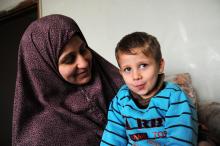Restoring Hope and Childhoods
Thursday, May 7, 2015
Ahmad*, an 11-year-old Syrian boy, was having a hard time managing his anger. In Syria, he had survived a grenade attack when he was mistaken for a soldier. His family sought safety in Amman, Jordan, but life was still not peaceful. Ahmad had violent outbursts. He was aggressive and hit his siblings. He had internalized the violence from his experiences in Syria into his own young body.

Increasingly, our staff in Jordan is seeing children and young people like Ahmad who need mental health and physical therapycare to cope with their traumatic experiences. Now, more than a third of our clients in Jordan are under the age of 18. Syrian adults report that the well-being and potential of their children constitute their greatest source of stress. Parents worry constantly about what their children have seen and experienced.
Children like Ahmad have survived targeted torture and random violence. Family members have been abducted or killed. Boys and girls as young as nine have been raped. These children and young people now struggle with debilitating nightmares, fear and anxiety.
Few children are able to attend school because of safety concerns or family obligations. Those who attend school may be marginalized by teachers. They may be bullied — or become bullies themselves. Syrian children also often express overwhelming responsibility for protecting their family. While still young, they may stand guard at apartment doors or resist sharing their feelings with their parents.
To help heal these young survivors, the counseling and physical therapy staff developed ten-week joint physical therapy/counseling groups that provide age-appropriate activities. “Young children can’t verbally express themselves very well. They don’t have the vocabulary to explain their feelings,” said Veronica Laveta, clinical advisor. “And they typically don’t have the ability to sit still for long periods of time, so the combined groups address both physical and emotional concerns.”
“On the counseling side, we’re helping the children understand that their feelings of anger and sadness are normal,” said Veronica. “Then they are learning to identify those feelings in themselves and find appropriate ways to express those feelings.”
“We have many fun activities that reinforce the counseling,” said MaryAnn de Ruiter, physical therapy advisor. “But physical therapy itself promotes healing through greater body awareness. The children learn how to use their bodies to interact more positively with peers or improve their self-confidence.”
During a typical meeting, leaders discuss an emotion such as anger, fear or sadness. Then, through a story or role-play, the children learn healthy ways to manage their emotions.
“Trauma happens just as intensely in the mind through thoughts as it does in the body through physical reactions,” said Ilona Fricker, physiotherapist/trainer. “We teach children to recognize that when they feel sad that it’s not just in their minds, but also in their bodies. Their posture changes. Their heads hang low. They walk slowly. During the groups, we talk about sadness and act it out. Then we talk about happiness and act that out. Finally, we teach them how they can use their bodies to make themselves feel better. For example, lifting your head up and straightening your back will stimulate positive emotions when you’re feeling bad.”
One favorite activity is “Kings and Queens.” One at a time, each child walks into the room wearing a crown and sits in a chair decorated as a throne. The other children then compliment the king or queen. The activity teaches the children how to carry themselves and to recognize feelings of pride and confidence.
The children learn other simple techniques to help them manage their feelings, such as focused breathing, counting, self-talk, guided imagery, singing and dancing. When practiced in the group and then at home, children do a better job managing their fears and anger.
Parent Education
Because of the nature of the Syrian conflict, many families are fragmented. Frequently, mothers are left to parent and provide for their children alone, while also dealing with their own grief and trauma. For parents and children alike, managing emotions is extremely difficult.
Through education groups, parents learn about typical child development issues, as well as common behaviors of children who have experienced trauma. The classes also provide suggestions to help both parents and children heal from their experiences, such as alternatives to physical discipline, speaking quietly, relaxation techniques, soothing rituals and having physical exercise.
Parents also learn the physical therapy techniques their children are learning so they can do them together to strengthen the family bonds.
“Both the parent education groups and the child physical therapy/counseling groups have been helpful in bringing a little peace to Syrian families,” said Veronica. “With more peaceful homes, these children have more hope for healthy, productive lives.”
After Ahmad’s group ended, his mother reported to CVT staff how much he had improved. Ahmad taught his mother breathing exercises and they now practice breathing together. Instead of hitting his siblings when he gets angry, he puts on the radio and dances. “He has changed and is almost back to normal before the war,” she said.
*The client’s name has been changed to protect his identity.
CVT’s activities in Jordan are financed by the United States Department of State’s Bureau of Population, Refugees and Migration (BPRM), the United Nations Voluntary Fund for Victims of Torture, and the support of the American People through USAID.
http://www.cvt.org/blog/healing-and-human-rights/restoring-hope-and-childhoods